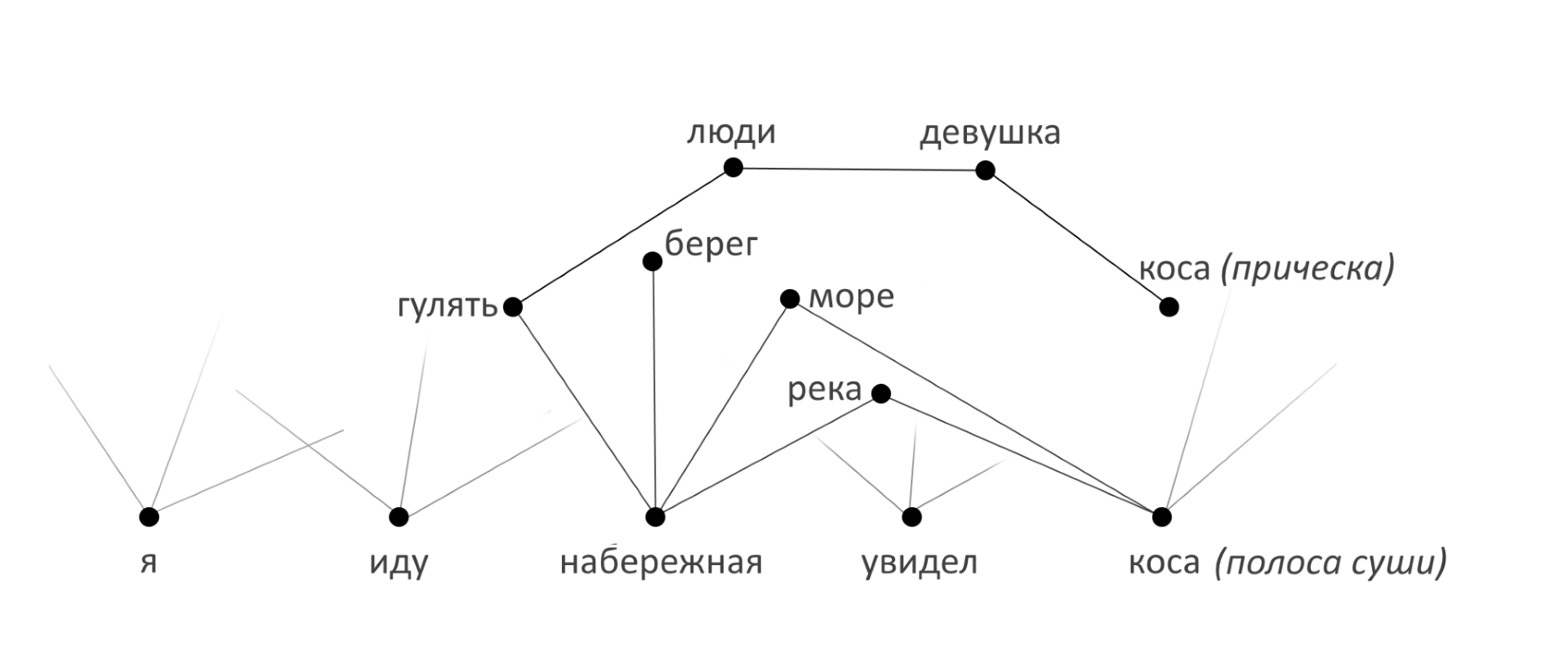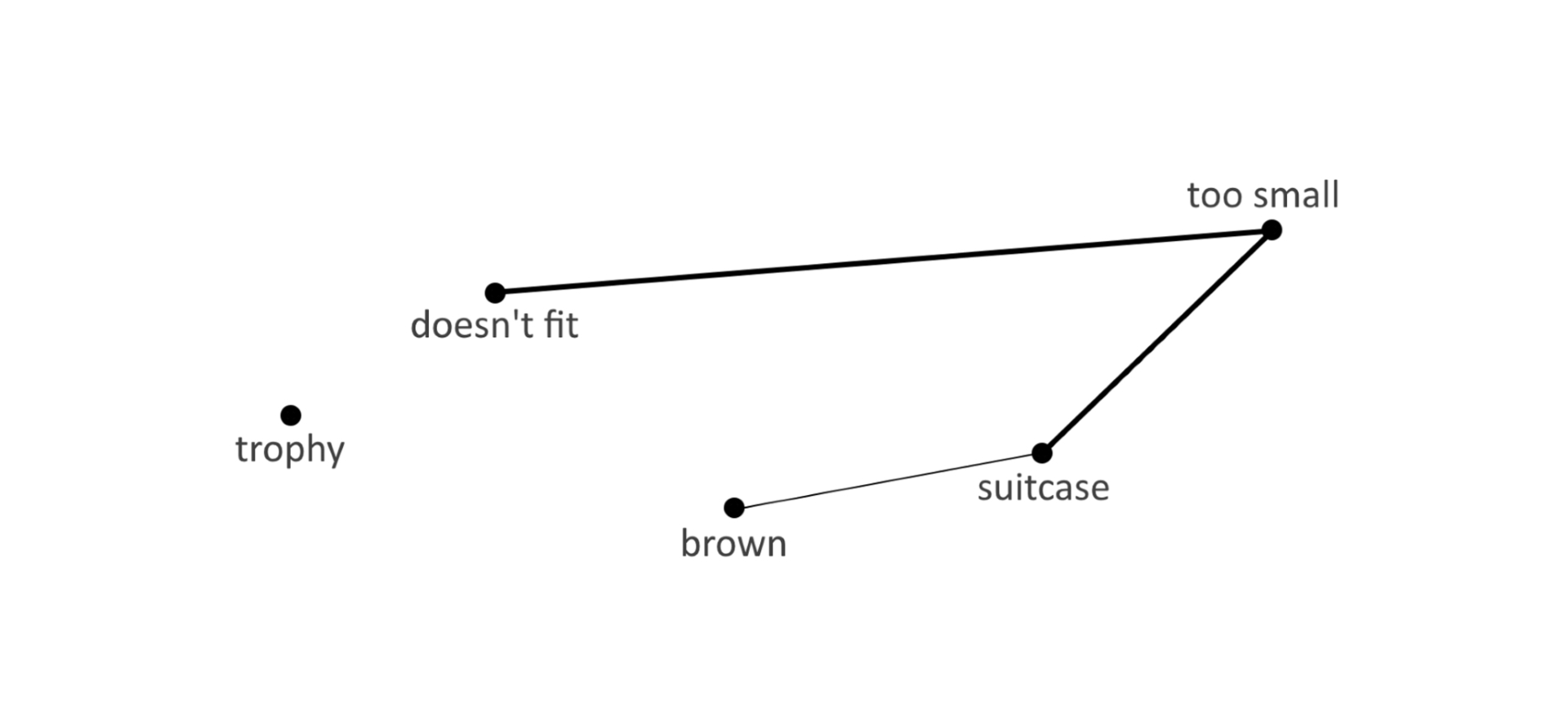Solving the problem of understanding the context of artificial intelligence. Part 1

Understanding natural language is a complete AI task . One aspect of this understanding is the understanding of the context. In this article I will explain what kinds of context our psyche highlights, how it works with one kind of context, and how we recreate this process in our artificial intelligence technology.
The trophy doesn't fit into the brown suitcase because it's too [small / large].
What is too [small / large]?
Answers: The suitcase / the trophy.
The Winograd Schema Challenge
The previous article described our approach to the development of AI and what we have already done so far. Let me remind you that we create AI by directly copying structures and processes of the human psyche.
Two kinds of context
From the comments on the previous article, we saw that the term “context” is used to describe very different situations. We consider this term, dividing it into two types.
The first kind of context is when it comes to understanding, arising from the concepts expressed in this phrase. These are situations of choosing one of the meanings of homonyms, picking up a synonym, choosing one of the nuances of meaning, etc. For example: “Her eyes were watering when she cut onions for salad” and “Modern archery is divided into several directions”. Man “on the fly” understands when it comes to the onion-plant, and when about the bow - a variety of weapons.
The second kind of context is when it is necessary to distinguish a certain category for understanding, often in the text itself not presented or not particularly highlighted. It is this category that makes it possible to formulate a certain “idea,” expressing in general what is being said.
For example, if you meet the phrase “He has printed a letter ...” in the book of Leo Tolstoy, then for a correct understanding of the text you attract the category “19th Century”, and conclude that this is not about a printer. This kind of context implies that, in order to understand and interpret the text, not only the entire text, but also the data associated with it can be analyzed.
The solution of problems associated with different types of context is served by completely different processes of the psyche. We repeat the same division in our development of AI. In solving problems of the first type, a method based on the peculiarities of knowledge storage is used. In solving problems of the second type, a more complex algorithm is implemented, based on experience (in the case of artificial intelligence, we are talking about algorithms that compensate for the lack of real human experience of the system), and involving a greater amount of computation.
The human psyche most often first tries to apply the first method, since It requires much less computing resources. If the solution does not look adequate, then the psyche uses the second. In addition, the higher the intelligence, the more often the second method is used and the greater the number of possible contexts taken into account. Children, in view of the complexity and resource intensity of the second method, as well as adults who are not used to mental labor, prefer the first.
We describe how our AI technology works with the first kind of context. How we work with the second, more complex, will be described in the next article.
Longer spit that has fewer connections
To illustrate, let's take a dialogue situation:
“I am walking along the embankment and saw a scythe. I wonder what is the longest spit? ”
A solution built on neural networks, due to limitations imposed by the method itself, most likely will not be able to adequately respond. Even if a lot of texts will be downloaded to the National Assembly to search for an answer, then, based on probability, the figure “5.6 meters” will sound.
Let me remind you that we develop our AI technology by consistently copying the psyche and its processes. The semantic network that we use to store knowledge reflects the characteristics of storing and processing information by a person. Therefore, in the framework of our approach, the problem is solved quite simply.
In the solution, corresponding to the age of seven, the algorithm refers to the semantic network and finds a vertex that is located in the node to which the words heard earlier belong. In the example above, it is necessary to choose one of the homonyms correctly: spit (hairstyle) and spit (land line connected to the shore) spit (tool). For this, it is analyzed which node of the semantic network was discussed earlier. Those. the simplest procedure for calculating the minimum distance to the concepts used in the text earlier is performed. In our network, distance is a function of the number of links (directly proportional) and their probability (inversely proportional).

The distance from the “spit (sushi strip)” to the “embankment” will be two orders of magnitude less than from the “spit (hairstyle)” to any of these concepts. AI will give the answer "110 km."
It should be noted that this task is also solved in the second way, with a category highlighted, for example, the “Volga River, next to which our interlocutor”.
Movers see suitcases differently.
Consider the example from the Vinograd scheme given at the beginning of the article:
“The trophy doesn't fit into the brown suitcase because it's too small. What is too small? ”The

connection between“ doesn't fit ”and the combination“ too small ”-“ suitcase ”is an order of magnitude more likely than between“ doesn't fit ”and“ too small ”-“ trophy ”. AI will give the answer "suitcase".
The presence of a high probability of such a connection, suggesting an order of magnitude smaller distance in the chain “doesn't fit” - “too small” - “suitcase”, is due to human experience. I, like most, often faced with a situation where something does not fit into a suitcase, as it is too small. Hence, I have such a connection. The same links are formed in the process of learning AI (more about the formation of various types of links in the psyche, we describe in one of the following articles about our semantic network).
“The trophy doesn't fit in the brown suitcase because it's too large. What is too large? ”The

connection between“ doesn't fit ”and the combination of“ too big ”-“ trophy ”is much more likely than between“ doesn't fit ”and“ too big ”-“ suitcase ”. AI will give the answer "trophy".
I will note a peculiarity - for movers, who often face a situation when you have to put an oversized suitcase, the psyche uses the second method of understanding the context. Because for them, the “too big” - “suitcase” connection is more relevant. At the same time, another system works for tourists - along with the increasing experience of situations when it is difficult to place a suitcase somewhere, the impossibility of the construction increases, “it is impossible to put something in a suitcase because the suitcase is too big”.
For a solution corresponding to 12 years of age, the formula is somewhat more complicated. Moreover, the approach formed by this age is realized in an adult - after 12 years, this part of the network-algorithms is not complicated.
In fact, the ease of decision is determined by the specifics of our campaign. All situations related to communication, all linguistics, are formed with the participation of structures of the human psyche. Actually, all the specifics in the field of language and is determined by these structures. True, there is a reverse process when a language defines a structure. There is a mutual condemnation. It is not surprising that with the help of these structures (mental) tasks that arise are solved in the easiest way. The nut must be unscrewed with a wrench, they are made for each other. Not a spoon.
I note that in addition to the great advantages, our approach to the development of AI introduces some difficulties. Computational architecture does not correspond to the physiological basis, and we periodically solve technical problems on the qualitative mapping of the processes and structures of the psyche in the figure. Also, due to the existing assumptions and corrections, some of the resources are spent on ensuring the identity of the semantic network and AI algorithms to the structures and algorithms of the real psyche.
The next article will be about the second kind of context, and it will, unfortunately, be much more heavyweight. We can not do without a deep immersion in psychological processes in the description of algorithms for working with the second type of context in our technology.
